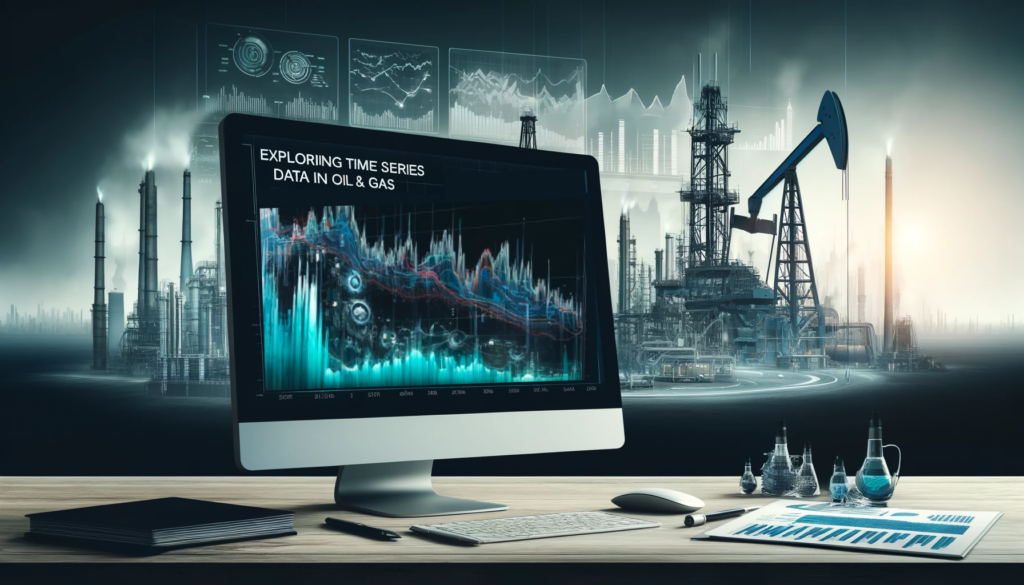Understanding Time Series Data in the Oil and Gas Industry: A Practical Guide
The oil and gas industry is a dynamic and complex sector where the analysis of time series data plays a crucial role in decision-making processes. Time series data, which consists of sequences of data points taken at successive equally spaced points in time, is pivotal in forecasting, anomaly detection, and performance analysis in this industry. In this blog, we will explore how time series data is used in the oil and gas sector, providing forecasting examples and a Google Colab notebook for hands-on exploration. Of course data is needed to work with. In a previous article we explore complexities of data management here.
Importance of Time Series Data in Oil and Gas
In the oil and gas industry, time series data can be found in various forms, such as production rates, equipment sensor readings, market prices, and environmental monitoring data. Analyzing this data helps in understanding trends, making predictions, and optimizing operations. Here are a few examples where time series data is particularly valuable:
1. Production Forecasting
Time series analysis is used to forecast future production rates based on historical production data. This forecasting helps in planning and ensuring the optimal exploitation of resources. For example, using time series models like ARIMA (AutoRegressive Integrated Moving Average) or LSTM networks (Long Short-Term Memory networks), companies can predict future production levels, taking into account seasonal variations and known declines in production rates.
2. Equipment Maintenance and Failure Prediction
Sensor data from equipment such as drills, pumps, and compressors can be analyzed using time series techniques to predict maintenance needs or potential failures. By identifying patterns or anomalies in the data (like increased vibration levels or temperatures), maintenance can be scheduled proactively, minimizing downtime and extending the equipment’s life span.
Errors using inadequate data are much less than those using no data at all.
Charles Babbage
3. Market Price Analysis
The oil and gas market is highly volatile. Time series analysis of market prices helps in understanding trends, seasonality, and volatility, enabling better financial decision-making. Techniques such as GARCH (Generalized Autoregressive Conditional Heteroskedasticity) models are often used to model and forecast volatility in oil prices.
Let’s explore production forecasting in more detail.
Production Forecasting Using Time Series Data
Production forecasting in the oil and gas industry is a critical activity that helps in managing resources efficiently, planning future operations, and guiding investment decisions. Forecasting involves predicting future production levels based on historical production data. This section delves deeper into how time series data can be utilized for production forecasting, highlighting the techniques and methodologies commonly used.
Understanding Production Data
Production data in the oil and gas sector typically refers to the quantity of oil or gas produced over a given period, which could be daily, monthly, or annually recorded. This data can exhibit various patterns such as trends, seasonality, and cyclic behavior, which are crucial for developing accurate forecasting models.
Forecasting Methodologies vs. Classification
The choice of forecasting methodology largely depends on the nature of the production data and the specific requirements of the forecasting task. This is in contrast to classification problems where the objective is to classify as a kind of type while forecasting looks at predicting the next values in the series. Here are some common techniques for forecasting.

ARIMA (AutoRegressive Integrated Moving Average):
Description: ARIMA models are well-suited for non-seasonal univariate time series data that may or may not exhibit trends and cyclicality. These models combine three main aspects: autoregression (AR), differencing (I), and moving averages (MA).
Application: In oil and gas, ARIMA can be used to model and forecast the production rates where the data shows trends or non-seasonal patterns. The model is particularly useful in adjusting for past values (autoregression) and smoothing out noise or fluctuations (moving average).
Seasonal ARIMA (SARIMA):
Description: SARIMA extends ARIMA by adding seasonality components, making it suitable for data with seasonal effects. It includes additional seasonal elements in the AR, differencing, and MA components.
Application: SARIMA can effectively model production data that exhibits seasonal peaks and troughs, allowing for more accurate predictions during specific times of the year.
Exponential Smoothing:
Description: This method uses a formula to assign exponentially decreasing weights over time. It is ideal for data with trends and seasonalities and can be adapted for simple to complex scenarios.
Application: Techniques like Holt-Winters exponential smoothing are applied to forecast production when data includes a trend as well as seasonal variation, providing a straightforward and computationally efficient model.
Machine Learning Models:
Description: Advanced machine learning models such as Random Forests or Neural Networks (e.g., LSTM – Long Short-Term Memory networks) can capture complex nonlinear relationships and interactions in the data that traditional statistical models might miss.
Application: LSTMs are particularly good for datasets where the sequence and time steps between data points are important. They are capable of learning order dependence in sequence prediction problems—useful in scenarios where past production rates are influenced by a confluence of factors including operational conditions and market dynamics.
You can read more and a case study here
TimeGPT
An interesting Generative model has been developed that uses similar technology to ChatGPT to generate the expected result. We will take a look using a hands on example and comparing to traditional methods.
Hands-on Exploration with a Google Colab Notebook
To provide hands-on experience with time series data in the oil and gas industry, we have prepared a Colab notebook. The data set was taken from a fictitious well for illustrative purposes and is not real.
Schedule a virtual coffee chat
To learn more about your opportunities, competitiveness, and how you can take advantage of your opportunities from our point of view.